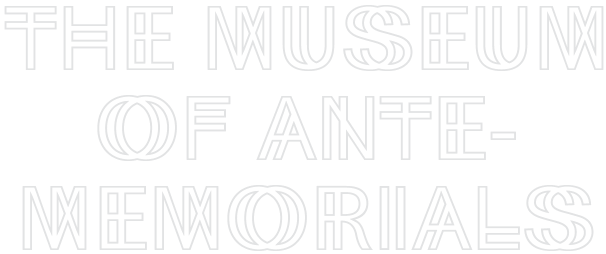Memorials are usually created after catastrophes, commemorating the dead and reminding us that we should do all we can to prevent such tragedies in the future. But the unending proliferation of war memorials suggests that this second function, the prophylactic one, doesn’t always work as hoped. What happens if the sequence is reversed? Can memorials also be constructed before the fact, in the place of, or in order to prevent an actual event from happening?
The Museum of Ante-Memorials explores this question by bringing together a constellation of films and documents that expand our understanding of the memorial. It explores the relation of memorials to past and future, to actuality and possibility. It brings together fictions—imaginary scenarios, constructed facts— with documents relating to historical events that actually took place, in order to explore where the scenarios they describe begin to overlap. The museum presents fictions that become documents before the fact, documentaries of a possibility, and documents that open up fictional spaces. In this sense, the ante-memorials in this exhibition stage different scenarios: what actually was versus what will have been and the possibility of what could have been.
The inaugural work in this museum is Peter Watkins’s film The War Game, produced and censored by the BBC, depicting a nuclear attack on Great Britain in the 1960s. In the style of an actual news report or documentary, the film describes the devastating consequences of the destruction of the English county of Kent in a nuclear exchange with the Soviet Union. The extraordinary violence of the statistics enumerated in the voice-over, and the relentless shots of children in agony, of mass graves and of burned flesh, have a striking reality-effect that leaves us in shock even today, fifty years after it was made. “Fiction” here “mocks” reality as it seeks to prevent this reality from becoming actual.
After Watkins’s film, the viewer encounters a series of collages by Robert Filliou titled Commemor(Commission Mixte d’Échange de Monuments aux Morts / Joint Commission for the Exchange of War Memorials) from 1970. The work is a proposition: “As for these countries which nowadays are thinking of going to war, they could consider exchanging their war memorials before instead of making it.” Filliou’s proposition is visualized with pictures of actual war memorials in Holland, Germany, and Belgium, which the Fluxus artist has crudely cut out and swapped with scissors and glue, turning existing war monuments into ante-memorials.
Hiroshima’s Peace Memorial Museum is an actual memorial, packed with documents, artefacts, and personal accounts of the first atomic bombardment, along with scientific perspectives on the Manhattan Project. The Museum of Ante-Memorials presents two historical documents from Hiroshima, which, in an inversion of Watkins’s and Filliou’s gestures, open disturbing imaginary sce-narios of what could have been.
The first is an American memorandum addressed to the Secretary of War, in which a committee of scientists from the Manhattan Project recommend that the bomb should be dropped onto an unpopulated island as a warning to the Japanese, in order to avert the widespread horror a civilian bombing would produce and the inevitable international arms race it would trigger. The advice of the inventors of the bomb to the politicians that would use it went like this: “If America would be able to say to the world, ‘You see what weapon we had but did not use. We are ready to renounce its use in the future and to join other nations in working out adequate supervision of the use of this nuclear weapon.’” The Franck Committee’s advice was prescient but went unheeded, a window into the alternate history of what could have been.
The second document recalls the fate of the city of Kokura, Japan, the planned target of the second atomic bombardment on August 9, 1945. It is a film shot from an observation plane showing the B-29 bomber Bock’s Car making three circles over Kokura in search of a hole in the unexpected cloud cover that makes it impossible to visually identify the target. Bock’s Car eventually diverts to a secondary target: Nagasaki. These images of a silver plane navigating the beautiful blue sky evoke the horror of reality juxtaposed with a vision of what was avoided, the strange fate of one city saved from hell, and another one doomed, by a few white clouds.
Finally, the film The Dud Effect by Deimantas Narkevičius presents the flipside of the fictional events of Kent in 1965: this film simulates the launch of R-14 nuclear missiles from a Soviet base in Lithuania in the 1970s. The Dud Effect is the inverse of The War Games from a narrative standpoint (depicting the launch instead of the impact) but also in terms of style: every effort is made to render the action ordinary, bureaucratic, methodical. The aftermath is suggested by shots of surrounding nature, the sound of strong wind, and a series of long takes of current Soviet-era nuclear installations in an advanced state of decay. Is it a post-apocalyptic world, or simply the spoils of time, the reassuring evidence of the end of the Soviet empire? And if it’s the second hypothesis, why are we not comforted by these images of a past that never was? To the Hiroshima museum’s would have been, to Watkins’s will have been, and to Filliou’s simple conditional, we witness Narkevičius’s was not. In this conjugation of works, among other constants linked to their “memorial” value, it is essentially a question of time and truth, or of how time puts the notion of truth in crisis.
